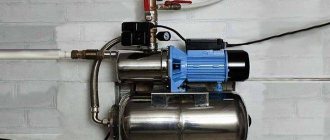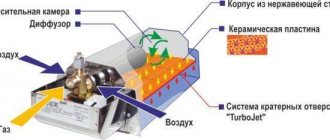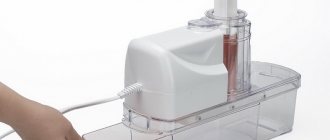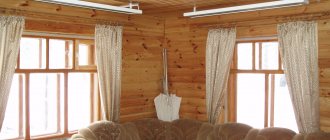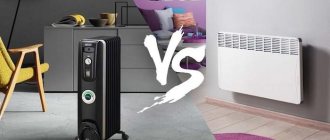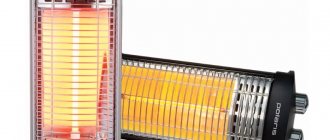Here you will learn:
- Operating principle of oil heater
- What is the difference between an oil heater and a convector?
- Which is better – a convector or an oil heater?
- Types of oil heaters
- How to calculate the required heater power
- How to choose an oil heater
Electric household oil heaters are simple and very reliable heating equipment designed for use in residential and office premises. They are characterized by good heat dissipation, convenient operation and safety for others. Most often they are used as auxiliary equipment, but nothing prevents them from being used independently.
What will we talk about in our review?
- About the principle of operation of oil heaters.
- About the types of such devices.
- About the criteria for choosing heaters.
We will also share knowledge on how to calculate the power of electric heaters for rooms of a given area.
Operating principle of oil heater
The first such devices appeared several decades ago. They are remembered by people who lived in the USSR - many people had such heaters in those years. Today, when centralized heating systems operate more or less steadily, the boom in them has subsided. But in some cases they become an indispensable source of heat. The main advantages of oil heaters are their efficiency and long-term heat retention .
The older brother of modern oil heaters, originally from the USSR.
The oil radiator circuit is very simple - there is a heating element inside that heats the mineral oil. It accumulates heat and releases it to surrounding objects. Some of the heat is transferred to the atmosphere by convection. To ensure a balanced temperature in the room, the devices are equipped with thermostats. They monitor the set temperature by turning the heating elements on and off.
The use of oil as a kind of coolant made it possible to ensure long-term heat retention - by analogy with cast iron batteries. The oil temperature rarely exceeds +60 degrees , which ensures the safety of the equipment and the absence of burns. When the heating element turns on, it begins to accumulate heat, heating up to the set temperature. After turning off the heating element, the temperature drops very slowly, since the heat is not released immediately. Thanks to this, radiators are able to save energy and create a comfortable atmosphere with a stable air temperature.
Such a simple principle of operation of an oil heater makes this equipment the simplest, cheapest, most economical and efficient. And the absence of hot elements makes them absolutely safe for others.
Review of the best models with a thermostat
Ballu Classic BOH/CL-11
Powerful oil heater with built-in thermostat and 11 sections heats the room quickly and efficiently
total area up to 27 sq. m.
The device is of a floor-standing type; it is easy to move from place to place due to the convenient handle and maneuverable wheels.
In case of overheating, the heater turns off. Mechanical control, with one operating mode. The power is adjustable, you can set it to 2200/1200/1000 W.
The temperature can be adjusted to suit your needs. There is a compartment for the cord on the case, now the wire will not get tangled under your feet. Operates from a 220 W network.
Characteristics:
- How much area does it heat - 27 sq. m.
- Power - 2200 W.
- Number of modes - 1.
- Number of sections - 11.
pros
- economical energy consumption;
- good stability;
- convenient to move;
- works without noise and smell.
Minuses
- quiet crackling sound when cooling;
- short power cord.
Ballu Comfort BOH/CM-07
Powerful and stable oil heater with built-in thermostat and 7 sections quickly and efficiently
heats a room with a total area of up to 20 square meters. m.
The device is of a floor-standing type; it is easy to move from place to place due to the convenient handle and maneuverable wheels.
In case of overheating, the heater turns off. The case has rounded edges, which increases the safety of the device. Mechanical control, with one operating mode.
The power is adjustable, you can set it to 1500/900/600 W. The temperature can be adjusted to suit your needs. There is a compartment for the cord on the case, now the wire will not get tangled under your feet. Operates from a 220 W network.
Characteristics:
- How much area does it heat - 20 sq. m.
- Power - 1500 W.
- Number of modes - 1.
- Number of sections - 7.
pros
- efficiency;
- saving energy consumption;
- easy to move from place to place.
Minuses
- short power cord;
- at medium power, an overheat shutdown often occurs.
Scarlett SC 51.2409 S5
Floor-standing and powerful oil heater with built-in thermostat and 9 sections quickly and efficiently
heats a room with a total area of up to 23 square meters. m.
The device is easy to move from place to place due to the convenient handle and maneuverable wheels.
Overheating protection is installed; the device turns off at the right moment. Mechanical control, with two operating modes. There is a built-in fan. The power is adjustable, you can set it to 2400/1200/1000 W.
The temperature can be adjusted to suit your needs. There is a compartment for the cord on the case, now the wire will not get tangled under your feet. Operates from a 220 W network.
Characteristics:
- How much area does it heat - 23 sq. m.
- Power - 2400 W.
- Number of modes - 2.
- Number of sections - 9.
pros
- compact dimensions;
- quiet operation;
- does not emit odor;
- uses energy economically.
Minuses
- The power cord is short.
What is the difference between an oil heater and a convector?
An electric convector itself does not emit heat, it only heats the air, causing it to circulate around the room.
Electric convectors heat exclusively due to natural air convection - heated air rises upward from the heating element, and colder air masses take its place. The constant movement of air leads to the fact that the heated room becomes noticeably warmer. At the same time, surrounding objects do not heat up with the help of convectors, since there is practically no thermal radiation from them.
It should be noted that in electric convectors the heating elements only heat the air, which instantly heats up and is sent upward. They do not need to heat the coolant, which has a large thermal capacity. Therefore, heating of rooms using convectors is faster than using oil heaters . But they consume significantly more electricity.
In addition to convection, oil radiators themselves emit heat.
As for oil heaters, the heating is double - using thermal radiation and convection. Thermal radiation is emitted by the metal bodies of the heaters, and the ribbed design ensures the creation of convection. At the same time, the maximum case temperature rarely exceeds +65 degrees. The disadvantage is that they heat noticeably slower. And they are larger in size than simple convectors.
The exception in terms of size is flat models without fins, which are somewhat reminiscent of the most ordinary steel panel heating radiators.
What else differs an oil heater from a convector? In principle, there are no other differences, except for the heating method. Almost the same thermostats are used here as in convectors, analyzing the air temperature and turning the heating elements on/off.
Pros and cons of oil radiators
Main advantages. Fire safety. The oil radiator does not have any open heating circuit, which means it will not be able to ignite any material.
Even if the radiator is covered with something, the automatic protection will work and the device will be disconnected from the power supply.
Heat distribution throughout the room
Many electric heaters create a directed flow of heated air, which quickly evaporates through cracks in the roof and walls. An oil radiator is a completely different matter - it warms up evenly, and then the heated air is distributed throughout the room. In this case, the heat will remain in the room for a long time.
Energy efficiency
If we compare radiators with other air heaters, then the oil radiator is the most economical in terms of electricity consumption. This is due to the fact that it uses a little electricity for a short period of time, and then the oil, as it warms up, releases it to the air in the house.
There are different numbers of radiator sections, so you can heat both small and large rooms.
Can work with thermostat
This feature of the device can significantly reduce energy consumption. Since in this case the radiator will turn off when a certain air temperature in the room is reached.
Many DIYers know how to make an oil heating radiator with their own hands with a thermostat, so even an old model of an oil radiator can be modified.
Silence
The heaters operate completely silently, which cannot be said about convectors with built-in fans. And with an oil heater you can take a quiet nap and it won’t bother you one bit.
Flaws
- The heater takes a long time to warm up. The heating radiator will need about 15-20 minutes to reach operating temperature. It will need about the same amount to completely cool down.
- Mixing of air masses in the room is too slow. Especially when compared with fan convectors, the air from the radiator circulates too slowly. It will take about half an hour for a room of 20 square meters to warm up well and evenly.
- Radiators for heating large rooms are too bulky, so manufacturers are trying to come up with all sorts of wheels for mobility. But this does not always help, especially when the floor is uneven and the radiator needs to be moved urgently.
Which is better – a convector or an oil heater?
Many consumers, when choosing heating equipment, cannot decide which is better, a convector or an oil heater? There is really a lot to think about here, so we will try to outline the pros and cons of this equipment, and then draw conclusions.
With the help of a special device on such radiators you can dry things without problems, which electric convectors cannot boast of.
- When choosing a convector or oil heater, you should take into account that convectors heat faster. But oil heaters allow you to retain the accumulated heat for a long time . If you want to heat up quickly, opt for convectors.
- Oil heaters are more economical. If you are afraid of large expenses, feel free to choose them. But be prepared for their slowness - this is their main disadvantage.
- Convectors are thinner and flatter - this is their big advantage, since finned oil radiators can cause child injuries. If you don’t want to see bulky equipment, take a closer look at convectors.
- The mobility of oil radiator heaters is much higher - if desired, such a heater can be pushed under the table. In the case of convectors, it is better to refuse such placement. Convectors heat rooms, but for local heating (if you want to sit near something warm) it is better to prefer an oil heater.
- It will not be possible to dry laundry on a convector - if it covers the upper ventilation holes, the device will overheat. As for oil heaters, they are often used to dry baby diapers and other small items. With such operation, they almost do not overheat, but the efficiency drops slightly ( however, this is not recommended ).
What can we say in the end? If efficiency and quick heating of the entire room are important to you, take a closer look at convectors. Do you want a local heat source? Then we recommend buying an oil radiator-heater.
You also need to pay attention to the fact that oil heaters are usually used as auxiliary heating devices - they come in handy on days when the heating is not working very well. As for convectors, they can work as independent heating equipment.
Which oil heater is best to buy in 2021?
Thus, it’s not worth believing marketing like: “only this product does not raise dust” or “only this device does not dry out the air.” If you don’t know which oil heater to buy, start from objective parameters, real customer reviews and financial capabilities, ignoring marketing and its components. If you are interested in the opinion of the “Central Committee”, then the conclusion is as follows:
- A good budget heater is TIMBERK TOR 21.1005.
- Balanced model of high efficiency – Ballu Classic BOH/CL-05;
- The best oil model for an apartment is Electrolux EOH/M-6105;
- Reliable and powerful home heater – Zanussi ZOH/CS-11W.
With this we propose to summarize our rating.
Types of oil heaters
When going to the nearest store to buy a new heater, you should first familiarize yourself with their varieties. There are not very many of them, but it still doesn’t hurt to mention them. There are the following types of oil heaters:
- floor;
- wall;
- heaters with fans;
- heaters with humidifiers.
Floor oil radiators
Floor-mounted oil radiators-heaters are the most common heating devices . They are installed on legs with wheels and can be moved from place to place. Most often, they are large in size and equipped with fins, which increase heating efficiency and convection. Floor-standing models have been produced for decades and delight consumers with warmth, coziness and comfort.
Wall oil heaters
Wall-mounted oil heaters cannot be called the most common heating equipment. They are rarely found on sale, but have good characteristics. In terms of their dimensions, they are thinner than their floor-standing counterparts, but there are no fins here. In appearance, wall-mounted models resemble steel panel radiators or electric convectors (only without ventilation holes).
Oil heater with fan
An oil heater with a fan combines the advantages of a convector, a heat gun and a conventional oil radiator. Low-noise fans are installed here, which forcefully send heated air outside. As a result, the heating speed increases significantly - in this way, models with fans resemble heat guns and conventional electric convectors.
Oil heaters with humidifiers
Heaters with air humidifiers have an extremely simple design - there is a container for water, which is a source of steam.
The result of the operation of such heaters is an increase in the level of air humidity - it becomes easier for a person to breathe, the functioning of the mucous membranes is normalized, well-being improves, and performance increases. Humid air is beneficial not only for adults, but also for children. If you want to purchase an oil heater for a children's room, make sure that it is equipped with a humidifier.
Review of the best floor models for apartments
Zanussi ZOH/ES-09WN
Floor-mounted oil radiator with a power of 2000 W, heating rooms up to 24 square meters. m. Mechanical control,
with one operating mode, there is power adjustment up to 2000/1200/800 W.
Has temperature control and a built-in thermostat. There is a cord compartment, wheels and a handle for easy movement. Has a fireplace effect.
Operates when connected to a 220 W network, without noise or odors. Does not dry out the air. 9 sections heat the air evenly and maintain a comfortable temperature.
Characteristics:
- How much area does it heat - 24 sq. m.
- Power - 2000 W.
- Number of modes - 1.
- Number of sections - 9.
pros
- efficiency;
- maneuverability;
- sustainability;
- there is a thermostat.
Minuses
- It clicks when it cools down.
Electrolux EOH/M-5157N
Floor-mounted oil radiator with a power of 1500 W, heating rooms up to 20 square meters. m.
The control is mechanical, with one operating mode, there is power adjustment up to 1500/900/600 W, which allows you to set the optimal mode for each room and save on electricity .
Has temperature control and a built-in thermostat. There is a cord compartment, wheels and a handle for easy movement. Has a fireplace effect. When overheating, automatic shutdown is activated.
Operates when connected to a 220 W network, without noise or odors. Does not dry out the air. 7 sections heat the air evenly and maintain a comfortable temperature.
Characteristics:
- How much area does it heat - 20 sq. m.
- Power - 1500 W.
- Number of modes - 1.
- Number of sections - 7.
pros
- stable;
- effective;
- convenient to move;
- does not emit odor.
Minuses
- clicks loudly when turned on and off;
- There are examples with low build quality.
Ballu Level BOH/LV-05 1000
The device belongs to floor oil heaters, the power is adjustable, you can set the indicators in
1000/600/400 W. This allows you to use the heater in any room.
The maximum heating area is 15 square meters. m. Turning on and off is indicated by a light indicator on the control panel.
Has temperature control and a built-in thermostat. There is a cord compartment, wheels and a handle for easy movement. No fireplace effect. When overheating, automatic shutdown is activated.
Operates when connected to a 220 W network, without noise or odors. Does not dry out the air and does not burn oxygen. 5 sections heat the air evenly and maintain a comfortable temperature.
Characteristics:
- How much area does it heat - 15 sq. m.
- Power - 1000 W.
- Number of modes - 1.
- Number of sections - 5.
pros
- thermostat;
- convenient to move;
- stable;
- does not make noise;
- economical consumption of electricity.
Minuses
- not detected.
How to calculate the required heater power
We have written a lot about calculating power for various types of heaters. And all calculations boil down to the fact that for heating 1 sq. m of living space requires 100 W of energy. Some manufacturers claim that this is a lot and give figures equal to 70-80 W per 1 sq. m. But for the Russian climate, which is characterized by cold weather, exactly 100 W per “square” is needed (in the south a little less, and in Siberia and beyond the Urals even a little more - up to 120-150 W) .
You can find out the amount of thermal energy for heating residential premises in your area from heating specialists. We will take 100 W per 1 sq. as a basis. m.
Table for calculating heater power.
In order to heat a room of 20 square meters. m, we will need a 2 kW oil heater. If you want more uniform heating, you should purchase two heating devices of 1 kW each. Your room measures 10-15 square meters. m? In this case, you can get by with one oil heater. The main thing is to choose the right power of the equipment so that the room is not cold. During the calculation process, we take into account the following data:
- ceiling height - the standard formula (100 W per 1 sq. m) is valid for ceilings with a height of 2.7 meters. For rooms with high ceilings, the heating capacity is 1 sq. m should be increased ;
- ratio of window area to floor area - the smaller this ratio, the higher the heat loss. They need to be compensated by increased power of heating devices;
- window design - single-glazed windows increase heat loss, it is necessary to increase power. Owners of triple-glazed windows can count on reduced heat loss;
- wall design - the better the thermal insulation, the less heat loss and the lower heating costs;
- climatic features of the area - the lower the average temperature in the coldest week of the year, the higher the power of the heating equipment used should be;
- number of external walls - in corner rooms with two external walls, heat loss is always higher than in rooms with one external wall.
The calculations also take into account many other factors, which we have already written about more than once in our reviews.
Review of the best models for the home in terms of price-quality ratio
Ballu Level BOH/LV-09 2000
Oil radiator with power adjustment 2000/1200/800 W, suitable for heating rooms up to 25 sq. m.
9 sections help to quickly and efficiently warm up the air. Operates from a 220 W network. The case has a compartment for the power cord.
Convenient to move from room to room due to maneuverable wheels and handle. The control is mechanical, with one operating mode, you can set the temperature.
A light indicator indicates when the device is turned on and off. In case of overheating, the device turns off automatically. There is a built-in thermostat.
Characteristics:
- How much area does it heat - 25 sq. m.
- Power - 2000 W.
- Number of modes - 1.
- Number of sections - 9.
pros
- stable;
- long power cord;
- quiet operation;
- overheat protection.
Minuses
- There is a strong smell when you first turn it on.
Ballu Level BOH/LV-11 2200
Sustainable oil radiator for heating rooms of 27 sq. m. The power of the device is 2200 W.
It can be adjusted by setting the indicators to 2200/1200/1000 W.
Mechanical control, temperature adjustment available. There is a built-in thermostat.
It is convenient to move the device from room to room due to the handle and nimble wheels. Overheat protection installed. 11 thin sections maintain a comfortable temperature in the room without drying out the air. The case has a compartment for the cord.
Characteristics:
- How much area does it heat - 27 sq. m.
- Power - 2200 W.
- Number of modes - 1.
- Number of sections - 11.
pros
- Ease of use;
- efficiency;
- long power cord;
- laconic design.
Minuses
- not detected.
Zanussi ZOH/CS-11W
Sustainable oil radiator for heating rooms of 27 sq. m. The power of the device is 2200 W.
It can be adjusted to 2200/1500/1000 W.
Mechanical control, temperature adjustment available. There is a built-in thermostat. Operates on 220 W mains and has a fireplace effect.
It is convenient to move the device from room to room due to the handle and nimble wheels. Overheat protection installed. 11 thin sections maintain a comfortable temperature in the room without drying out the air.
It operates silently and does not emit any pungent odors. The case has a compartment for the cord.
Characteristics:
- How much area does it heat - 27 sq. m.
- Power - 2200.
- Number of modes - 1.
- Number of sections - 11.
pros
- sustainability;
- heating efficiency;
- quiet work.
Minuses
- weight - 11 kg;
- It clicks when it cools down.
How to choose an oil heater
Which oil heater is better? The best heater is the one that can cope with heating your home - it should be suitable in power. All other criteria affect ease of use and ease of management. But the brand is very important, since cheap Chinese junk has a low level of reliability . As for well-known brands, their products have high build quality.
We also recommend paying attention to the following characteristics:
An electronically controlled device is better because you can more accurately regulate the temperature in the room.
- electronic control - it is more accurate than mechanical, so energy costs may be slightly reduced;
- the presence of protection against overheating - will extend the service life of oil radiators-heaters;
- the presence of a rollover shutdown will protect you and your property;
- the presence of frost protection - will not allow your house to freeze during your long absence (will also save money during this period);
- the presence of a fan will provide faster heating.
When choosing oil-based household electric heaters, you need to take a closer look at the cost of the purchased equipment - the optimal prices for heaters vary between 2-3 thousand rubles for models with a power of 1 kW.
Advanced premium models
It is worth noting! Such models are distinguished by high power, performance, additional functions and high cost.
This is a suitable option for buyers who are not strapped for cash, or for people with a life credo to use the best, regardless of financial costs.
VITEK VT-2129
The VITEK VT-2129 oil radiator is one of the most prominent representatives of the line of high-class models from the world's leading brand.
The manufacturer positions its device as a device with an increased level of safety.
The radiator automatically disconnects from the network if it overheats or falls; a bright light indicator indicates the condition of the unit.
Another feature of the model is the large number of sections (13 pieces), allowing the heater to be used in medium-sized rooms.
Key parameters:
- power levels - 1000, 1500, 2500 W;
- heating area - 20 m2;
- sections - 13 pcs.;
- operating modes - 1;
- thermostat;
- mechanical control with temperature adjustment;
- light indication;
- protection against overheating and overturning;
- wheels, handle, cord compartment;
- weight - 12.7 kg.
Advantages
- high power;
- light indication in the power button;
- there is a fireplace effect;
- elegant design;
- two protection options.
Flaws
- expensive;
- heavy weight;
- no ventilation without heating.
Midea MOH3003
The MOH-3003 model features not only an impressive design, but also increased power, sufficient to heat an apartment, small warehouse or office space.
The equipment is equipped with a mechanical control unit with a thermostat sensor to change the heating level.
The manufacturer paid a lot of attention to ergonomics (the device is equipped with small wheels and a handle) and safety (the floor-standing device automatically turns off if it tips over and overheats).
Key parameters:
- power - 2300 W;
- heating area - 25 m2;
- sections - 11 pcs.;
- operating modes - 1;
- thermostat;
- mechanical control with temperature adjustment;
- light indication;
- protection against overheating and overturning;
- wheels, handle, cord compartment;
- weight - 11 kg.
Advantages
- attractive appearance;
- a large number of sections;
- powerful;
- protection, the unit itself is resistant to capsizing;
- high-quality assembly.
Flaws
- does not apply to compact models;
- high price;
- There is no air convection system (fan).
Polaris PRE W 0920
The Polaris PRE W 0920 heater has all the options necessary for high-quality heating and a more attractive price compared to its competitors.
The Polaris PRE W 0920 oil-filled radiator is suitable for heating a small room.
Among the distinctive features of the device are three heating levels, safety options, an indicator light and a comfortable handle for moving.
Several sections of the heating element housing increase the performance of the device.
Key parameters:
- power levels - 800, 1200, 2000 W;
- heating area - 20 m2;
- sections - 9 pcs.;
- operating modes - 1;
- thermostat;
- mechanical control with temperature adjustment;
- light indication;
- overheat protection;
- wheels, handle, cord compartment;
- weight - 8.6 kg.
Advantages
- bright indicator light built into the switch;
- attractive price for a premium device;
- several heating modes;
- high level of security.
Flaws
- short power cord;
- not too high power.
Review of the best energy-saving models
Scarlett SC 51.2811 S5
Powerful oil radiator for heating large rooms with a total area of up to 28 square meters. m. Operates on 220 W network,
There is power adjustment. 11 sections quickly heat the air, and the built-in thermostat maintains a comfortable temperature.
There is a fan that distributes heat quickly and evenly. Mechanical control, with two operating modes. In case of overheating, the device turns off.
The case has a cord compartment for convenient storage. The heater can be easily moved from place to place due to the convenient handle and nimble wheels.
Characteristics:
- How much area does it heat - 28 sq. m.
- Power - 2900 W.
- Number of modes - 2.
- Number of sections - 11.
pros
- power adjustment significantly saves energy;
- easy to move;
- simple controls;
- suitable for large rooms.
Minuses
- short power cord.
Ballu BOH/TB-07FH
Powerful oil radiator for heating large rooms with a total area of up to 20 square meters. m. Operates on 220 W network,
There is a power adjustment of 1500/900/600 W. 7 sections quickly heat the air, and the built-in thermostat maintains a comfortable temperature.
There is a fan that distributes heat quickly and evenly. The control is mechanical, with two operating modes, there is temperature adjustment. In case of overheating, the device turns off.
The case has a cord compartment for convenient storage. The heater can be easily moved from place to place due to the convenient handle and nimble wheels. The body has an anti-corrosion coating.
Characteristics:
- How much area does it heat - 24 sq. m.
- Power - 1500.
- Number of modes - 2.
- Number of sections - 7.
pros
- durability;
- hidden cord storage system;
- power adjustment.
Minuses
- not detected.
Ballu BOH/TB-09FH
Powerful oil radiator for heating large rooms with a total area of up to 20 square meters. m. Operates from a 220 W network, there is a power adjustment of 2000/1200/800 W. 9 sections quickly heat the air, and the built-in thermostat maintains a comfortable temperature.
There is a fan that distributes heat quickly and evenly. The control is mechanical, with two operating modes, there is temperature adjustment. In case of overheating, the device turns off. The case has a cord compartment for convenient storage.
The heater can be easily moved from place to place due to the convenient handle and nimble wheels. Stylish and laconic design in black and white colors suits any interior.
Characteristics:
- How much area does it heat - 28 sq. m.
- Power - 2000 W.
- Number of modes - 1.
- Number of sections - 9.
pros
- 400 W fan heater;
- stability and convenient movement;
- build quality;
- quiet operation;
- power adjustment.
Minuses
- weight 10 kg.
Review of the best models with overheating protection
Ballu Cube BOH/CB-05 W 1000
Compact but powerful oil heater with five sections, used in rooms up to 15 square meters. m.
Equipped with overheating protection. The maximum power is 1000 W, but you can set the indicators to 600 and 400 W. Powered by network.
Mechanical control with one operating mode. There is a manual temperature control and a light indicator for turning the device on and off.
Moves from place to place thanks to the ergonomic handle and maneuverable wheels. There is a cord compartment on the case so that the wires no longer get in the way under your feet.
Characteristics:
- How much area does it heat - 15 sq. m.
- Power - 1000 W.
- Number of modes - 1.
- Number of sections - 5.
pros
- economical consumption of electricity;
- quiet operation;
- convenient control;
- does not emit unpleasant odors.
Minuses
- Clicks when turned on and off.
Timberk TOR 21.1507 BC/BCL
Compact but powerful oil heater with seven sections, used in rooms up to 20 square meters. m.
Available in two colors: black and white.
The laconic design suits any interior. Equipped with overheating protection. The maximum power is 1500 W, but you can set the indicators to 1000 and 800 W. Powered by network.
Mechanical control with two operating modes. There is a manual temperature control and a light indicator for turning the device on and off. There is a built-in thermostat and fireplace effect.
Moves from place to place thanks to the ergonomic handle and maneuverable wheels. There is a cord compartment on the case so that the wires no longer get in the way under your feet.
Characteristics:
- How much area does it heat - 20 sq. m.
- Power - 1500 W.
- Number of modes - 2.
- Number of sections - 7.
pros
- stylish and laconic design;
- convenient control;
- thermostat;
- does not emit unpleasant odors;
- saves energy by adjusting power.
Minuses
- short power cord.
Electrolux EOH/M-6157
Compact but powerful oil heater with seven sections, used in rooms up to 20 square meters. m.
Available in white. The laconic design suits any interior.
Equipped with overheating protection. The maximum power is 1500 W, but you can set the indicators to 900 and 600 W. Powered by network.
Mechanical control with two operating modes. There is a manual temperature control and a light indicator for turning the device on and off. There is a built-in thermostat and fireplace effect.
Moves from place to place thanks to the ergonomic handle and maneuverable wheels. There is a cord compartment on the case so that the wires no longer get in the way under your feet. Heats the air quickly and evenly, maintaining a comfortable temperature.
Characteristics:
- How much area does it heat - 20 sq. m.
- Power - 1500 W.
- Number of modes - 1.
- Number of sections - 7.
pros
- saving energy by adjusting power;
- built-in thermostat;
- quiet operation;
- compact size and sleek design.
Minuses
- clicks when turned on and off;
- short power cord.
Which heater is best for a summer house?
Every summer resident knows how important it is to quickly warm up a country house used for seasonal living or weekend relaxation. This is especially true in the spring, with the onset of summer frosts and with the approach of autumn cold weather. Sometimes it is convenient to use electric heaters for this purpose. You just need to make sure that the heater power matches the characteristics of your electrical network. It is the state of the electrical network that sometimes causes difficulties in organizing heating using electrical appliances.
In domestic conditions in the country, the following types of heaters are most often used:
- convector;
- infrared;
- oil
A separate class of heating devices called heat guns is not discussed in this article. They produce increased noise and are not intended for use in domestic environments. Weak fan heaters do not have such disadvantages, but have low power, which does not allow them to effectively warm up the premises of a country house.
Convector heaters
Electrical devices of this type have a heating element that heats up to a high temperature, which gives off heat to air flows rising along its walls. When such a device operates, a fairly intense circulation of air masses occurs, which leads to rapid heating of the room.
Operating principle of a convector heater
The required heater power is selected based on a simple formula: 1 kW for every 10 m2 of area of the heated room. The lineup of any well-known brand is usually represented by products of very different performance. The system of settings and regulation allows you to adapt the operation of the heater to specific conditions.
Manufacturers offer convector heaters of various shapes and sizes. There are options for floor or wall installation. Modern models are equipped with automatic means that can maintain the temperature with an accuracy of a degree, provide a comfortable or economical operating mode, and turn on and off in accordance with a given program at a time specified by the user.
The safe operation of convector heaters is ensured by a special housing design that protects electrical equipment from water ingress, protection against overheating and blocking when tipping over.
+ Advantages of convector heaters
- High rate of room heating.
- Economical operation.
- Fire safety.
- No noise or emission of harmful substances.
- Easy installation and intuitive controls.
- The presence of several operating modes with precise maintenance of the set air temperature provided for a number of models.
- Possibility of not only permanent installation, but also movement around the house.
- There is no need for maintenance, just periodically wipe the dust from the outer surface of the case.
— Disadvantages of convector heaters
- Increased requirements for the reliability of electrical wiring.
- High tariffs for electricity consumption.
Features of application for a summer residence. When choosing convectors for a country house, you must take into account that one convector is designed to heat one room. If you need to heat several rooms, you will have to purchase a convector for each. For ease of use, convectors located in different rooms can be combined into one system with one control unit. This allows you to quickly and accurately regulate the temperature throughout your entire home.
Infrared heaters
This type of heating devices is based on the generation of heat rays. They are absolutely safe and are capable of heating surfaces at some distance from the source. In a similar way, the sun gives us its energy. In the area of operation of such a heater, a person feels as comfortable as possible.
The operating principle of an infrared heater
Infrared heaters can be attached to walls and ceilings. They are most effective when it is not necessary to heat the entire room, but only a certain area of it. They usually have an increased class of protection against moisture, which allows them to be used even in open areas, in showers and bathrooms. Most models of this type are designed for permanent installation. For the convenience of users, manufacturers often provide rotating devices that allow the heating area to be shifted.
+ Advantages of infrared heaters
- Long service life ensured by high reliability of the design and materials used.
- Fire safety.
- Possibility of use outside buildings and in rooms with high humidity.
- Ease of connection and setup.
- Possibility of centralized control of several devices.
- Complete replacement of heated floors.
- Maximum efficiency with spot and zone heating.
— Disadvantages of infrared heaters
- Only permanent installation is provided.
- There are restrictions on minimum and maximum ceiling heights.
- Low degree of control intelligence.
- There is a risk of overheating during prolonged use.
Features of application for a summer residence. All infrared heaters differ in the areas of infrared radiation.
Based on the impact on humans, the following areas of infrared radiation (IR-Infrared Radiation) are distinguished:
- Near (IR-A). Wavelengths from 0.76 to 1.5 microns, penetrate deeply under the skin (up to 4 cm);
- Average (IR-B). Wavelength from 1.5 to 3 microns, medium penetration;
- Far (IR-C). Wavelengths from 3 to 8 microns do not pass beyond the surface.
The human body perceives long-wave radiation best - (IR-C). But short-wave radiation (IR-A), with prolonged and intense exposure to the human body, can lead to negative consequences in the form of headaches or heat stroke. Since for your dacha you most likely need devices that you will use for a long time, you need to choose infrared heaters with long-wave radiation (IR-C).
You can understand which heater you have in front of you based on the type of heating element. The more short waves in the spectrum, the higher the temperature and the brighter the glow of the heating element. And vice versa, the more long waves in the spectrum, the lower the temperature, and the glow may be completely absent.
- Anodized aluminum panel heating elements - contain 98% of the IR-C spectrum.
- Quartz heating elements - contain 84% of the IR-C spectrum and 15% of the IR-B spectrum 15%.
- Carbon heating elements - contain 70% IR-C spectrum and 15 IR-B spectrum 29%.
- Halogen heating elements - contain 35% of the IR-A spectrum.
Thus, the most optimal option for human exposure is panel-type IR heaters, and it is advisable to use these devices to heat the premises of a country house. Panel IR heaters can be wall or ceiling mounted. As with convectors, you will need your own heater for each room. In this case, each heater must be located in such a place as to maximize the dispersion of infrared rays throughout the room.
Oil heaters
Such devices are an oil-filled metal case with embossed walls, inside of which a heating element is mounted. When it is turned on, the oil is first heated, which then gives off heat to the surrounding air. This design eliminates contact of external objects and people with hot surfaces.
The oil heater remains warm for some time after being turned off. This is not always convenient, as it leads to unreasonably high energy consumption. Heaters of this type are usually heavy, but are mounted on casters, making them easy to move around the house.
+ Advantages of oil heaters
- Duration of operation.
- Mobility.
- Simple and reliable control.
- Affordable price.
— Disadvantages of oil heaters
- Increased room warm-up time compared to other types of electrical appliances of similar power.
- Cracking during operation.
- No intelligent control.
- Impossibility of combining several devices into a single system.
- Large mass and excessive dimensions.
- Negative effect on indoor air humidity.
- The need for preheating when first turned on.
- Excessive waste of energy, since the device continues to produce heat even after it is turned off.
Features of application for a summer residence. Oil heaters are purchased for summer cottages when the priority factor of choice is the cheapness of the purchase and they are used as a temporary heating option using electricity. During operation, they are inferior in efficiency and ease of use. For the rest, we recommend paying attention to convectors or infrared heaters.
